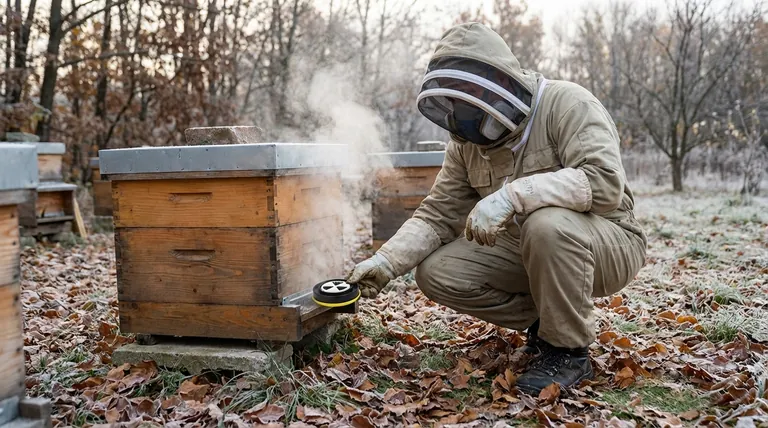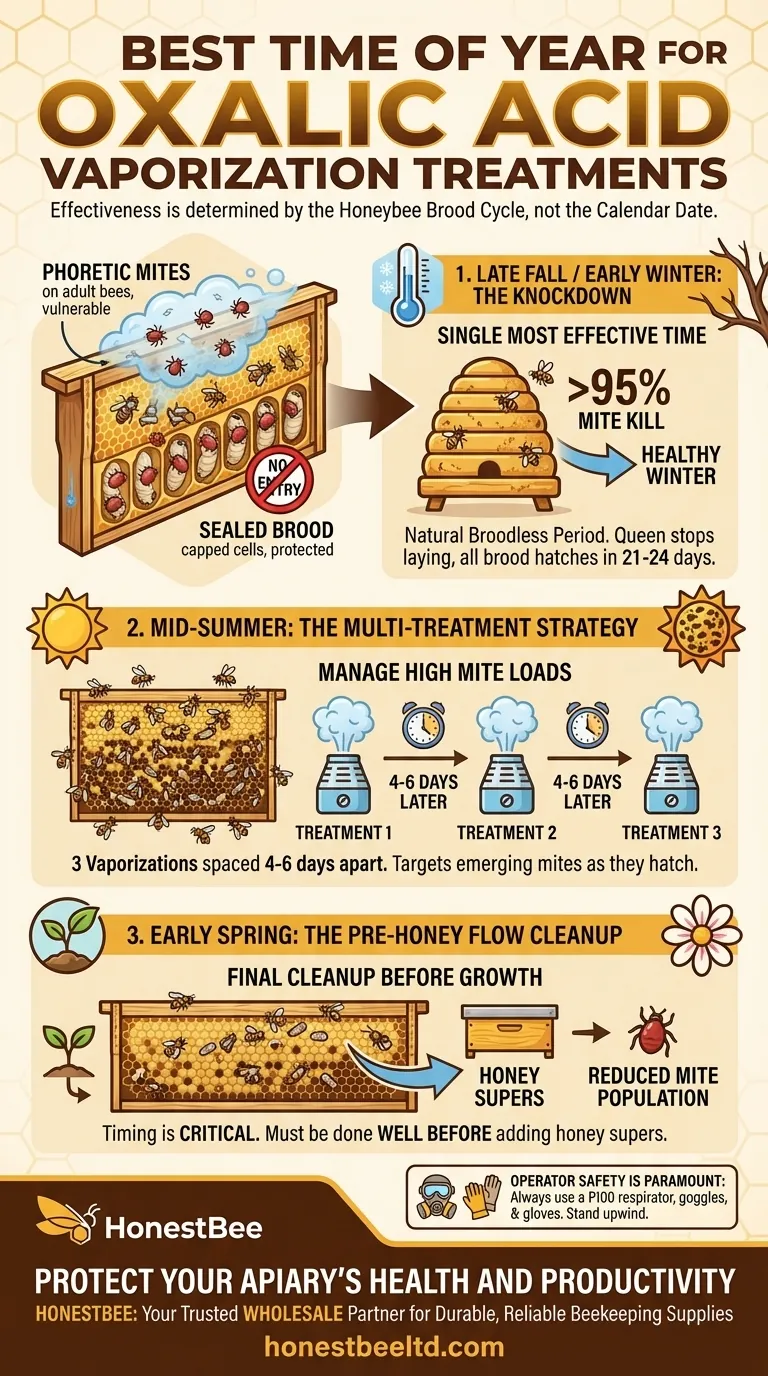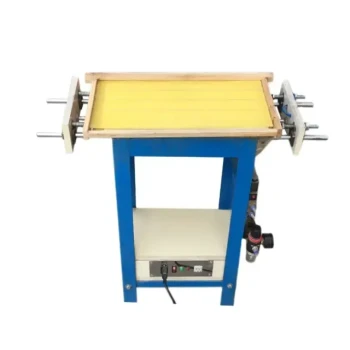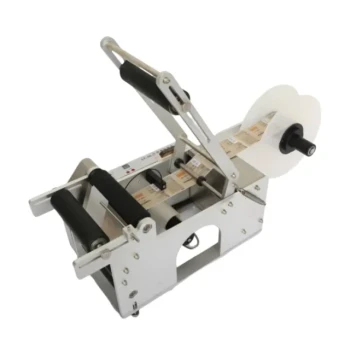The best time of year to perform oxalic acid vaporization is when the bee colony has the least amount of sealed brood. This typically occurs in late fall or early winter after the queen has stopped laying for the season. Other strategic windows include mid-summer and early spring, though these require a different approach.
The effectiveness of oxalic acid vaporization is not determined by the calendar date, but by the state of the honeybee brood cycle. Because the vapor only kills Varroa mites on adult bees (phoretic mites), the treatment is most potent when the mite population isn't hiding and reproducing inside sealed brood cells.

Why Brood Levels Dictate Treatment Timing
To use oxalic acid (OA) effectively, you must understand its single greatest limitation. It provides a powerful, targeted kill, but only on mites it can physically contact.
The Varroa Mite's Hidden Lifecycle
The majority of a Varroa mite's life is spent inside a sealed honeybee brood cell. Here, the female mite lays her eggs, which hatch and feed on the developing bee pupa. This is where the mite population explodes, safe from most treatments.
How Oxalic Acid Vapor Works
When the oxalic acid crystals are heated, they turn into a vapor that coats the surfaces inside the hive, including the bees themselves. This vapor is lethal to the phoretic mites—those riding on the backs of adult bees—but it cannot penetrate the wax cappings of the brood cells.
The "Broodless" Advantage
Therefore, any treatment is dramatically more effective when there is little to no capped brood in the hive. When no brood is present, nearly 100% of the mites are in their phoretic stage, making them completely vulnerable to the oxalic acid vapor.
The Three Strategic Treatment Windows
Based on this principle, we can identify three distinct periods in the beekeeping year for effective treatment.
Late Fall / Early Winter: The Knockdown Treatment
This is the single most effective time for an oxalic acid vaporization treatment. As cold weather sets in, the queen naturally ceases laying eggs. After about 21-24 days, all existing brood will have hatched, creating a natural broodless period. A single treatment during this window can wipe out over 95% of the hive's mite population, setting them up for a healthy winter.
Mid-Summer: The Multi-Treatment Strategy
Treating in summer is challenging because the colony is full of brood, meaning most mites are protected. However, mite loads can become dangerously high during this period.
To overcome this, a series of treatments is required. The "Three Time Summer Special" involves three separate vaporizations spaced 4-6 days apart. This schedule is designed to catch mites as they emerge with newly hatching bees, ensuring most are exposed to at least one dose of the treatment.
Early Spring: The Pre-Honey Flow Cleanup
A treatment can be performed in early spring before you add your honey supers. This is a final "cleanup" to knock back any mites that survived the winter before the population begins to grow exponentially. Timing is critical; this must be done well before any honey intended for human consumption is stored.
Understanding the Trade-offs and Risks
While effective, oxalic acid vaporization is a tool that requires proper understanding and execution.
The Core Limitation: No Effect on Brood
It is essential to remember that this treatment will not solve a major mite infestation if the hive is full of capped brood. A single summer treatment may kill some phoretic mites but will leave the vast majority of the mite population untouched and ready to emerge.
Operator Safety is Paramount
Oxalic acid vapor is corrosive and a severe respiratory irritant for humans. A properly fitted respirator with acid gas cartridges (e.g., P100), safety goggles, and gloves are non-negotiable safety equipment. Always stand upwind from the hive when treating.
Temperature and Hive Conditions
Treatment is most effective when bees are loosely clustered, allowing the vapor to circulate. Avoid treating in extreme cold, high winds, or when bees are tightly clustered for warmth, as this can reduce the treatment's efficacy.
Making the Right Choice for Your Goal
Your treatment strategy should be dictated by your specific objective for the hive at that time of year.
- If your primary focus is maximum mite reduction: Perform a single treatment in the late fall or early winter when the hive is confirmed to be broodless.
- If your primary focus is managing summer mite levels: Use the three-treatment method, spaced 4-6 days apart, to target mites as they emerge from brood cells.
- If your primary focus is a pre-season cleanup: Treat in the early spring before adding honey supers to reduce the starting mite population ahead of the main nectar flow.
Ultimately, mastering Varroa mite control with oxalic acid comes from aligning your treatment schedule with the natural brood cycle of your bees.
Summary Table:
| Treatment Window | Primary Goal | Key Consideration |
|---|---|---|
| Late Fall / Early Winter | Maximum Mite Reduction (>95% kill) | Hive is naturally broodless after queen stops laying. |
| Mid-Summer | Manage High Mite Loads | Requires 3 treatments, 4-6 days apart, to target emerging mites. |
| Early Spring | Pre-Season Cleanup | Perform before adding honey supers to reduce starting population. |
Protect Your Apiary's Health and Productivity
Mastering Varroa mite control is essential for the success of your commercial operation. The right equipment is just as important as the right timing.
HONESTBEE is your trusted wholesale partner, supplying commercial apiaries and equipment distributors with the durable, reliable supplies needed for effective treatments like oxalic acid vaporization. We help you safeguard your investment and maximize honey production.
Ready to equip your operation for success? Contact our wholesale team today to discuss your needs and volume pricing.
Visual Guide

Related Products
- Adjustable Formic and Acetic Acid Dispenser for Bee Mite Treatment
- Professional Galvanized Hive Strap with Secure Locking Buckle for Beekeeping
- Langstroth Screen Bottom Board for Beekeeping Wholesale
- Economy Small Scale Honey Dryer Dehumidifier Thickening Machine
- Beehive Handle and Frame Rest Cutting Machine: Your Specialized Hive Machine
People Also Ask
- What does Chewed Down Brood (CDB) indicate in bee colonies? A Sign of Varroa Mite Infestation
- What should be done after treating a colony for varroa mites? A Step-by-Step Guide to Verifying Success
- How can beekeepers ensure their hives survive the winter? A Guide to Colony Survival
- How do Varroa mites spread between honey bee colonies? Stop Mite Transmission in Your Apiary
- What are phoretic mites? A Beekeeper's Guide to Monitoring Varroa Infestation



















